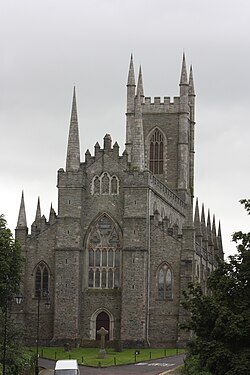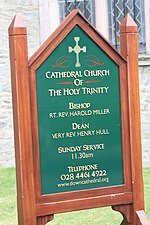Down Cathedral: Difference between revisions
Created page with "{{Infobox church |name=Down Cathedral |full name=Cathedral Church of the Holy Trinity |county=Down |picture=Down Cathedral (01), August 2009.JPG |picture caption=Down Cathedra..." |
No edit summary |
||
| Line 11: | Line 11: | ||
|built=1790-1818 | |built=1790-1818 | ||
|architect= | |architect= | ||
|church=Church of Ireland | |||
|diocese=Down and Dromore | |diocese=Down and Dromore | ||
|province=Armagh | |province=Armagh | ||
Latest revision as of 23:00, 11 June 2018
| Down Cathedral | |
|
Cathedral Church of the Holy Trinity | |
|---|---|
|
County Down | |
| Status: | cathedral |
 Down Cathedral, Downpatrick | |
| Church of Ireland | |
| Diocese of Down and Dromore | |
| Location | |
| Grid reference: | J48244447 |
| Location: | 54°19’39"N, 5°43’18"W |
| History | |
| Built 1790-1818 | |
| Information | |
| Website: | www.downcathedral.org |
The Cathedral Church of the Holy and Undivided Trinity, commonly known as Down Cathedral, stands at the top of the hill on which the town of Downpatrick is built, in County Down. From its position on Cathedral Hill, it looks down over the town, and forms the town's centre point.
This is the principal cathedral of the Diocese of Down and Dromore in the Church of Ireland; one of two cathedrals of the diocese, the other being Dromore Cathedral.
History

This is an ancient ecclesiastical site with a church dedicated to the Holy Trinity recorded in the 12th century. In 1124 St Malachy became Bishop of Down, and set about repairing and enlarging the Cathedral. In 1177, Sir John de Courcy, the Norman conqueror of Ulster, introduced Benedictine monks and expelled Augustinian monks settled there by St Malachy. De Courcy, who had enraged the king by his seizure of lands in Ireland beyond what he was granted, was taken prison there on Good Friday 1204. According to the account, the unarmed de Courcy managed to take a weapon from one of his attackers and killed 13 men before being overpowered and taken prisoner.[1]
By 1220, the church was in ruins and was further damaged by an earthquake in 1245. The Cathedral was burned down by Edward Bruce in 1315 and subsequently rebuilt and destroyed several times. In 1538 the monastery was suppressed and then destroyed in 1539 by Lord Leonard Grey, the Lord Deputy of Ireland, who stabled horses there. The destruction of the Cathedral was one of the charges for which Grey was executed in 1541. For two centuries after that it lay in ruins. In 1778 John Wesley, the founder of Methodism, visited and described it as a noble ruin. A Round Tower close to the Cathedral was taken down in 1790.
Restoration
The cathedral incorporates parts of the 13th-century church of the Benedictine Abbey of Down (Black Monks).[2]
The restoration of the ruined 14th century cathedral of Downpatrick was initiated after an Act of Parliament of 1790 granted £1,000 for the purpose.[3] The Earl of Hillsborough donated a further £568 and £300 a year of the deanery tithes were appropriated. The long chancel from the late mediæval cathedral was repaired and transformed into an aisled nave and chancel for the new cathedral. Charles Lilly directed the restoration, but it was so drastic that many details of the original building disappeared, as he aimed at reproducing an overall mediæval effect. Work was completed and the cathedral was ready for use in 1818. An octagonal vestibule and a Perpendicular Gothic tower were added to the west end in 1826.[4]
Crosses from the 9th, 10th and 12th centuries are preserved in the Cathedral. The building today is mainly the original chancel from the 15th century with a vestibule and tower added. It had a second major restoration from 1985 to 1987 during which time the Cathedral was closed.
About the cathedral
The cathedral houses an 11th-century granite font discovered in use as a watering trough in 1927 and installed in the Cathedral in 1931. In the Cathedral grounds is the reputed burial place of St Patrick, thought to have died in 461. However, the inscribed stone of Mourne granite allegedly marking the grave was actually put in place in 1900. Outside the east end of the Cathedral stands a weathered High Cross made of granite and dating from the 10th or 11th centuries. It used to stand in the centre of Downpatrick, but was moved to the Cathedral in 1897.
Two small stone crosses now built into a wall in Down Cathedral appear to be 12th century work and are carved with ecclesiastics with books.[2]

Outside links
| ("Wikimedia Commons" has material about Down Cathedral) |
References
- ↑ Berry, MRIA, Major R.G. (January 1906). "The Whites of Dufferin and their Connection" (in en). Ulster Journal of Archaeology (Ulster Archaeological Society) XII (1): 122. https://books.google.com/books?id=HgdKAAAAYAAJ&pg=RA1-PA122. Retrieved 28 December 2017.
- ↑ 2.0 2.1 Department of the Environment for Northern Ireland (1983). Historic Monuments of Northern Ireland. Belfast: HMSO. p. 50.
- ↑ DayPatton|45}}
- ↑ DeBreffny, D; Mott, G (1976). The Churches and Abbeys of Ireland. London: Thames & Hudson. pp. 148–149.
| Cathedrals of the Church of Ireland |
|---|
|
Province of Armagh:
Armagh •
Clogher •
Derry •
Downpatrick •
Dromore •
Elphin •
Enniskillen •
Killala •
Kilmore •
Lisburn •
Raphoe •
Sligo •
Tuam •
Belfast
|
